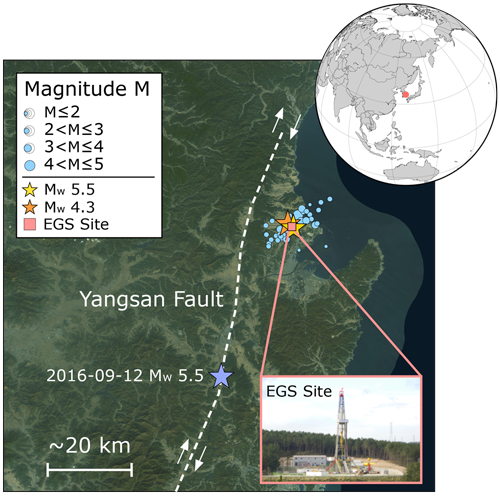Earthquakes and geothermal energy: lessons from Pohang

May 2019 - by Michèle Marti and Domenico Giardini
In November 2017, a magnitude 5.5 earthquake shook the South Korean city of Pohang, injuring over 100 people and causing $300 million worth of damage. Just a short time later, suspicion arose that the quake might have been triggered by a nearby geothermal project. This impression was backed up by two scientific studies. As a result, the South Korean government set up an international expert commission, whose members include Domenico Giardini, professor at ETH Zurich and head of the SCCER-SoE. This commission's recently published final report confirms that the geothermal project was indeed the cause of that highly destructive earthquake.
The commission examined the tectonic stress conditions, local geology, induced seismicity, drill data and details of the hydraulic stimulations associated with the geothermal project in Pohang, which was intended to construct a heat exchanger 4-5 km down in the crystalline bedrock. A similar petrothermal geothermal energy project was also attempted in Basel in 2006. Projects like this entail pumping fluid into the ground under high pressure. As expected, this triggers numerous minor quakes. Unnoticed by the operators, these injections in Pohang repeatedly set off earthquakes in quite a large previously unknown fault zone. This weakened the apparently tectonically pre-stressed fault line, leading to the magnitude 5.5 earthquake. Now that the causal link has been proved, the expert commission is asking what lessons can be learnt from the occurrence.
Its verdict on the project is far from positive. Indeed, looking back it can pinpoint failings at all stages of the undertaking. Before work began, geological studies had shown that some fractures were critically pre-stressed. Bearing in mind the proximity to a medium-sized city with a major industrial port, this finding should have prompted an adjustment of the project's risk assessment. Then the first hydraulic stimulations began at borehole PX-2. The geological reports state that large quantities of the fluid pumped into PX-2 seeped away. This is unusual, constituting another alarm signal, an indication that the borehole ran through a sizeable interference zone. Locally, the spillage of the injected fluid increased the pressure on the fault zone and already triggered numerous small earthquakes early on. Yet this increased induced seismicity was only analysed after the magnitude 5.5 earthquake.
The commission also looks into the two-month period between the last hydraulic stimulations and the damaging quake. This time lag has repeatedly been interpreted as indicative of no connection between the geothermal project and the earthquake. However, the report invokes findings from other projects which prove that induced seismicity often does not stop when hydraulic stimulations come to an end. The commission recommends involving the respective authorities and all relevant experts in the run-up to future projects, to draw up a comprehensive risk analysis and then keep it constantly updated. Furthermore, a reliable real-time monitoring system has to be set up, the processes and injection strategy must be constantly reviewed and, if need be, corrected, and risk mitigation measures need to be formally noted down and communicated.
The SCCER-SoE contributes in many ways to the development of procedures and techniques for a safe, efficient and long-term use of geothermal energy.
Authors

Michèle Marti is responsible for media relations and public relations for the Swiss Seismological Service and national and international research projects.
Professor Domenico Giardini is the Head of the Swiss Competence Center for Energy Research – Supply of Electricity (SCCER-SoE) and Professor of Seismology and Geodynamics at the Institute of Geophysics at ETH Zurich.
Learn more
Science article "Managing injection-induced seismic risk"
Report by the commission (in Korean and English, scroll down and click on link to PDF file)
Science article "The November 2017 Mw 5.5 Pohang earthquake: A possible case of induced seismicity in South Korea"

